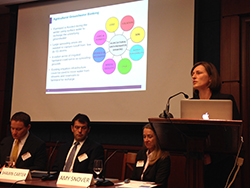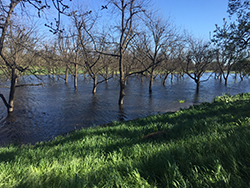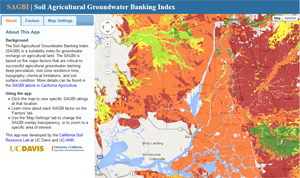Recent Coverage of our ResearchMedia, newspaper and blog articles since March 2017
|
How California is saving rainwater for a sunny dayMeet Helen Dahlke, a water banker, March 23, 2017 by Mary Beth Griggs – Outside the window of Helen Dahlke’s office, at the University of California at Davis, the clouds hang low, their edges seeming to brush against the building. It’s raining intensely, an unusual event in a perpetually parched state suffering from a five-year drought. “It looks like the end of the world,” says Dahlke happily.
As a hydrologist and professor who studies how water flows over and through rock, soil, fields, and farms, she is something of an H2O whiz. For the past two years, Dahlke has spent days like this doing what water conservationists might find abhorrent: standing in the rain, in knee-high rubber boots, opening sprinklers on a dormant farm or orchard, and letting them spray. She’s good at it. She can spray about 45 million gallons in 42 days. |
Groundwater Recharge in the NewsBlogs, newspaper and media coverage in 2017The following provides a compilation of news reports of our groundwater recharge research.
|
|
As Rains Soak California, Farmers Test How To Store Water UndergroundHeard on All Things Considered on January 12, 2017 Dan Charles, NPR – Six years ago, Don Cameron, the general manager of Terranova Ranch, southwest of Fresno, Calif., did something that seemed kind of crazy.
He went out to a nearby river, which was running high because of recent rains, and he opened an irrigation gate. Water rushed down a canal and flooded hundreds of acres of vineyards — even though it was wintertime. The vineyards were quiet. Nothing was growing.
"We started in February, and we flooded grapes continuously, for the most part, until May," Cameron says.
|
|
Water Security in the WestA Science Briefing on water for people and nature, October 25-26, 2016 Washington, D.C. – Fresh water security is one of the most important and pressing issues facing the Na6on today. Drought
and changes in snowpack, runoff, and recharge threaten water supplies for millions of people, especially
in the West. Short-term fixes can lead to long-term declines in water supply and environmental changes
that exacerbate drought condi6ons, harm the ecosystems upon which people depend, and intensify the
risks of other hazards like wildfire.1 Planning, inves6ng in infrastructure, and incorpora6ng nature-based
solu6ons can help sustain and increase the supply of water for people and nature.
Read our Science Brief.
|
 |
State Water Board Issues its First Temporary Groundwater Storage Permit to Capture Rain Season High FlowsState Water Resources Control Board, January 15, 2016 SACRAMENTO – Today the State Water Resources Control Board (State Water Board) issued its first temporary groundwater storage permit to the Scott Valley Irrigation District to capture high winter and spring flows for local groundwater storage and recharge. The permit is the first in what is expected to be a series of temporary permits issued for this type of water diversion and use. The temporary permit application was submitted Jan. 13 by the District in coordination with staff at the University of California at Davis, the California Farm Bureau Federation, Scott River Water Trust and others. The District proposes to divert up to 5,400 acre-feet of water during high water events using existing diversion structures. Water will be diverted from the Scott River using the District’s unlined earthen canal system and spread onto as many as 3,475 acres of existing, dormant agricultural fields within the District’s service area for infiltration. |
Scientists Flood Almond Orchards To Restore Groundwater in CaliforniaNPR Capitol Public Radio, January 20, 2016 Almond farmers in California’s Central Valley have been villainized in the drought. The crop needs a gallon of water to grow a single almond. Now scientists are studying whether almond orchards can be used to help restore water to depleted aquifers. Some almond growers are flooding their orchards as part of the experiment. On Nick Blom's farm in Modesto, water pours out of an irrigation valve. Pretty quickly, it begins to cover six acres of almond trees in standing water. Blom says normally he wouldn’t water the trees this time of year. "I did have some concerns. You do risk root damage and other kinds of things that can happen to your trees," says Blom. |
Researchers test a possible drought solution by flooding an almond farmLA Times January 20, 2016 The El Niño rainstorm had already turned Nick Blom's almond orchard into a quagmire. Still, he wheeled open the lid of a massive irrigation pipe. Fifteen minutes later, a gurgling belch heralded a gush of water that surged over the lip of the pipe and spread across five acres of almond trees. Blom is neither crazy nor self-destructive. He's a volunteer in an experiment run by UC Davis that could offer a partial solution to California's perennial water shortages, and in the process, challenge some long-standing tenets of flood control and farming in the Central Valley. |
Governor Brown Issues Executive Order on Mandatory Extension on Water Use Reduction until October 2016Drought State of Emergency In a new executive order, governor Brown said that if the drought continues through January, mandatory water cuts will remain in effect until October. Brown's executive order directs state agencies to fast-track water projects that could help capture rain from the storms. Congressional Republicans from California have urged officials to come up with a plan to make the most of a potentially powerful El Niño. SWRCB will announce as early as Monday new proposed rate structures for temporary permits, that will be based on actually delivered water. It may be as little as $100 or even less and $0.10 per acre-foot. New rates are likely to be adopted at the December 4 meeting of the Board. |
AB 647, as introduced by congresswoman Susan EggmanBeneficial use: diversion of water underground. Under existing law, the right to water or to the use of water is limited to that amount of water that may be reasonably required for the beneficial use to be served. Existing law provides for the reversion of water rights to which a person is entitled when the person fails to beneficially use the water for a period of 5 years. Existing law declares that the storing of water underground, and related diversions for that purpose, constitute a beneficial use of water if the stored water is thereafter applied to the beneficial purposes for which the appropriation for storage was made. This bill would declare that the diversion of water underground constitutes a beneficial use of water for which an appropriation may be made if the diverted water is stored and thereafter applied to beneficial use or if beneficial use of the water, including, but not limited to, protection of water quality or recovery of groundwater levels, is made while the water is underground. This bill would provide that the period for the reversion of a water right does not apply to water being beneficially used in the aquifer or being held in storage for later beneficial use. AB 647 Bill |
Groundwater: The crucial challengeArticle published in Capitol Weekly on November 17, 2015 California’s single most urgent water policy priority is preserving our groundwater supply. In normal years, groundwater provides one-third of our state’s urban and agricultural water. In dry years, it provides up to nearly two-thirds. As the severe drought has brought new awareness of the importance of our groundwater safety net, California leaders have made significant public policy changes. They include the California Sustainable Groundwater Management Act of 2014; 2015 laws that streamline groundwater-dispute resolution; and new requirements under the state Porter-Cologne Water Quality Control Act of 1969. |
California Farmers Will Intentionally Flood Their Fields This WinterArticle published in Scientific AmericanTM on November 17, 2015 California is parched. Rivers that usually surge now trickle, and once large reservoirs stand as puny pools. Those most critically affected by the state's four-year drought are the Central Valley's farmers, whose livelihoods are threatened. Without rain to irrigate croplands, growers repeatedly turn to underground aquifers, but the overpumping has taken a toll, causing water tables to drop dramatically. |
Farmland May Provide Key To Replenishing GroundwaterArticle published on UC Davis News Feed on September 9, 2015 California’s aquifers are shrinking as more growers pump groundwater to keep crops alive. But that fertile farmland may also provide the means for replenishing groundwater to benefit everyone in the drought-stricken state. |
Soil Agricultural Groundwater Banking Index now on-lineThe Soil Agricultural Groundwater Banking Index (SAGBI) is a suitability index for groundwater recharge on agricultural land. The SAGBI is based on five major factors that are critical to successful agricultural groundwater banking: deep percolation, root zone residence time, topography, chemical limitations, and soil surface condition. More details on the derivation of the SAGBI can be found in this recent California Agriculture. To see if your agricultural soils are suitable for artificial groundwater recharge please visit the new SAGBI tool. |
AGU session on Drought, Groundwater Management, and Long-term Groundwater Sustainability in the Western United States: Assessment, Monitoring, Modeling, Planning, Management, and Policy [H031]American Geophysical Union (AGU) Fall Meeting, San Francisco 14 -18 DecemberJoin us at AGU for this session on the unprecedented 4-year drought in the Western United States. Invited speakers for this session are:
Abstract: Much of the Western United States has been in a long-term drought or series of multi-year droughts throughout the past two decades, a period that has also experienced significant shifts in urban, industrial, and agricultural water uses leading to unprecedented pressures on groundwater resources. This session examines drought impacts on groundwater resources, groundwater management, regional and state policy responses and implementation in the Western U.S., including implementation of the new Sustainable Groundwater Management Act of California. We invite studies that showcase innovative approaches to groundwater basin assessment, monitoring, modeling, and management under climate uncertainty, drought, and a changing water infrastructure landscape in the semi-arid Western US; analyze policy responses, effectiveness of management measures; evaluate best management practices for groundwater management agencies; define operational sustainability criteria for groundwater basins; and review roles of data collection, monitoring, and modeling/assessment. Conveners: Thomas Harter, Helen E Dahlke, Bridget R Scanlon, Samuel Sandoval Solis |
Research project in Stanislaus County will see if winter flood irrigation refills aquifersArticle published in The Modesto Bee on July 9, 2015 Almonds are a widely planted crop in California and water management in this crop has a significant impact on the state’s water budget.The current and foreseeable future drought conditions have raised two key issues for almond growers, both of which are related to water management during the winter months (December-February): 1) is winter irrigation necessary if there is no significant winter rainfall? and 2) is applying excess winter irrigation, for instance, to recharge groundwater supplies, detrimental to root and tree health? As part of a new project funded by the Almond Board of California UC Davis professors Ken Shackel (Department of Pomology), Helen Dahlke (Department of Land, Air and Water Resources), and Astrid Volder (Department of Plant Sciences) and farm advisors Roger Duncan and David Doll will conduct field studies over the enxt two years to (1) test the effectiveness of winter microsprinkler and/or drip irrigation as a sustainable groundwater recharge strategy, (2) document any negative or positive effects of winter irrigation on almond yield and/or root development, and (3) determine the threshold level of dormant tree water stress indicating the need for pre-bloom irrigation in dry winters. Read more here: http://www.modbee.com/news/article26919124.html#st... |
UC Davis seeks practical solutions for water needsOp-Ed in AgAlert on March 4, 2015 After another winter of below-average precipitation, California's water situation is severe and the short-term outlook is dire. But our situation is not hopeless. The drought’s clear and present danger to California’s agriculture and economy provides a unique opportunity to improve our state’s long-term water management through cooperation, shared vision, and science-based solutions. Researchers at UC Davis College of Agricultural and Environmental Sciences are working with growers, industry, and agencies throughout the state to find practical solutions. Here’s a quick look at some of the latest developments. Replenishing groundwaterProfessor Helen Dahlke with Land, Air and Water Resources and her team are making headway with groundwater banking, where excess surface water during storms and flood releases is directed to select fields to serve as infiltration basins to replenish aquifers. Dahlke’s team just began a two-month test in an alfalfa field near Scott River in Siskiyou County, applying water in various amounts to analyze soil saturation, infiltration rates, and whether the winter irrigation adversely affects the alfalfa. Read more ... |



